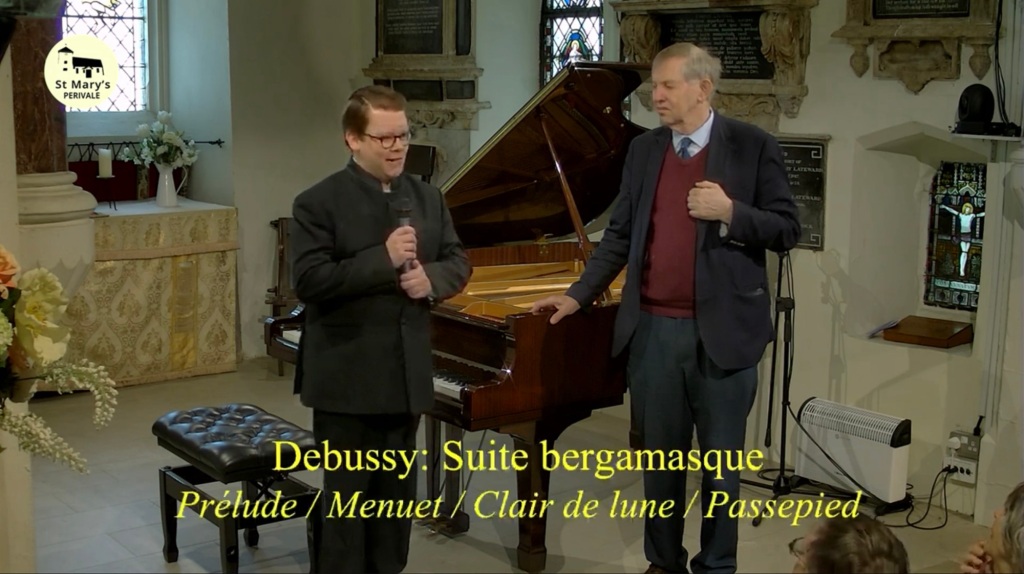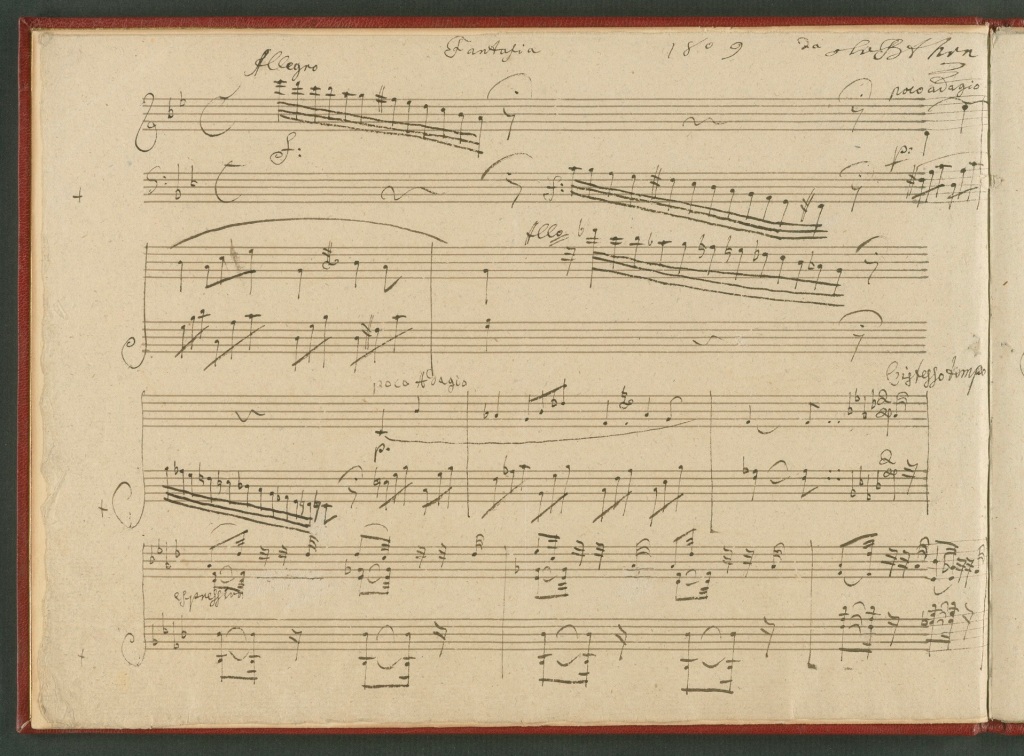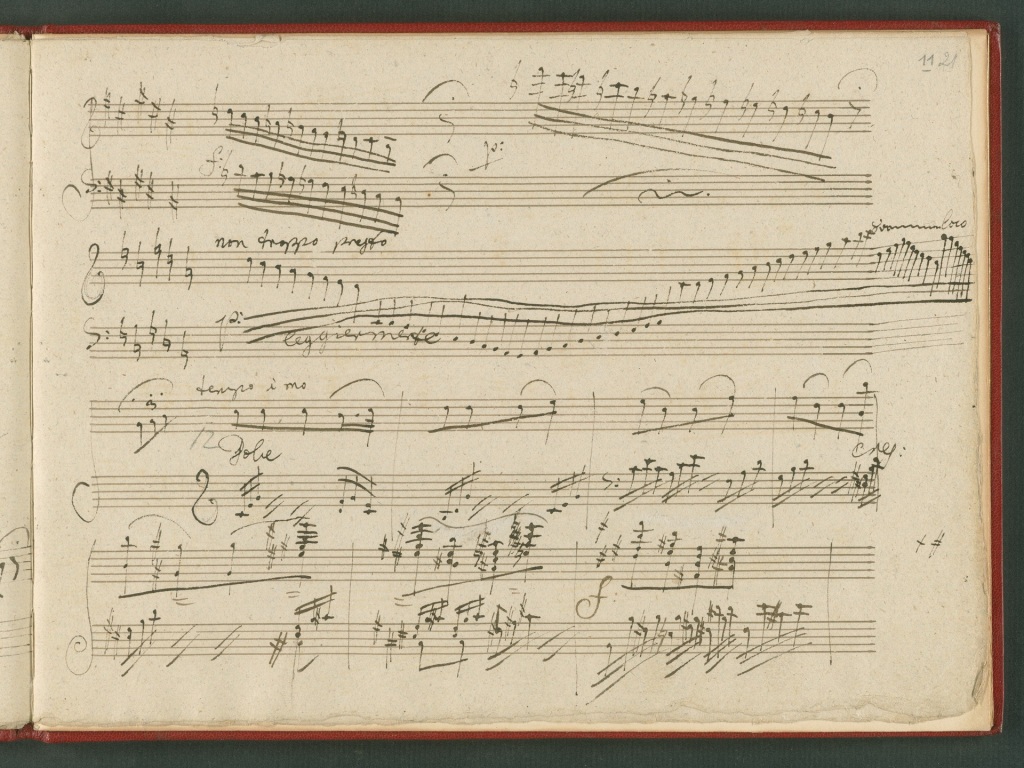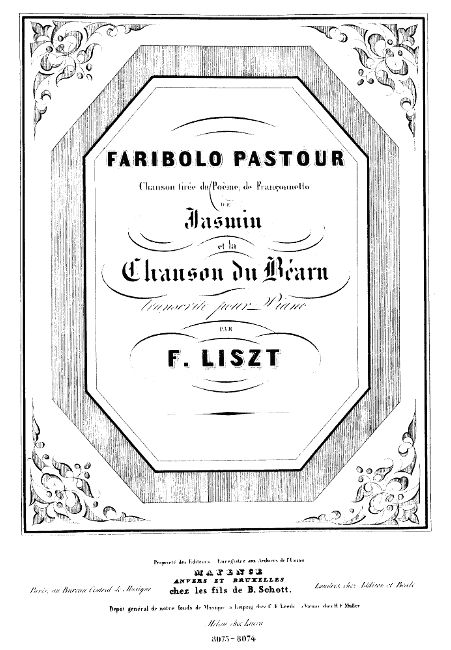

Well Dr Mather said it all when he exclaimed that he could not understand why this unique artist is not better known on the concert platform worldwide.
Endless amounts of CD’s of some of the most interesting repertoire receiving unanimous praise from the critics and live performances like today of impeccable artistry.
Sharing amazing insights into the life and times of musicians we have only before read about in books he also brought them vividly to life not only in words but above all in music.A critic in Vicenza could not believe her ears when she heard him playing Alkan and certainly found it hard to believe her eyes when she saw his score with a finger on every note – and there were many many notes scrawled across the page.

Today a Beethoven that we have often seen mentioned in books and thought of as a curiosity and a sort of try out for the Choral Fantasy – Mark showed us how wrong we could be with a performance of dynamic drive and luminosity and a chameleonic change of character that would have put Gilbert and Sullivan to shame .The last laugh of course was Beethoven’s with a final right hand slap in the bass !!

Two miniatures by Alkan of glowing fluidity and simplicity of a composer that Mark has long been championing.Ier recueil de chants op 38. A superb sense of balance in ‘Largement,quoique asset vif ’ allowed the left hand to provide washes of sound supporting a bel canto melody of great originality unlike any other composer although Mark had likened it to Mendelssohn seen through a dark lense! The repetitive motif in ‘Barcarolle:Andante ’ was of hypnotic beauty with neither piece of transcendental difficulty but both of quite exquisite simple beauty in Mark’s very sensitive hands.Fingers like limpets that dug deep into the keys to reveal secrets that had been hidden for too long.

Debussy’s refreshingly simple ‘Suite bergamasque ’ reborn with its original title and was of pure grace and charm.The grandiose Prelude opening was followed by the impish good humour of the Menuet and the limpid simple beauty of Clair de lune originally entitled ‘Promenade sentimentale’. A Passepied that Mark thought was the real highlight of this suite with its beguiling half lights and insinuating playful ‘joie de vivre’. A true lesson in style and control with a mastery of sound that brought this charming suite vividly to life.

Chopin’s Polonaise Héroique played as Chopin wrote it with nobility and aristocratic control.Such well known works as this can fall into a rhetorical tradition in lesser hands .Mark looks at the score with disarming innocence and can reveal secrets hidden by years of layers of dust and show us just exactly what Chopin wrote.A transcendental technical control that allowed him to master the cavalry into orderly legions so the bugle calls could ride so nobly in its wake.A finale of breathtaking nobility and exhilaration showed us the refreshingly insightful musicianship of a master.

And finally Liszt’s ‘Carnaval de Pesth’ that finished this glittering Carnaval Promenade with a performance of such mastery that as Dr Mather exclaimed he made one of Liszt’s longest and most complicated Rhapsodies seem so simple.
His introduction to the Liszt encore was so enticing that the magic was set even before he touched the keys.Faribolo Pasteur S.236/1 I have only ever heard from Leslie Howard’s hands and it is enough to say that Mark and Leslie are colleagues.Both with an insatiable appetite for delving into the archives and bringing long lost masterpieces to the fore.
Mark is chairman of the Alkan society and Leslie of the Liszt Society and the world is without doubt a better place with them at the helm.

Described by International Piano Magazine as “one of the most gifted pianists of his generation”, Mark Viner is steadily gaining a reputation as one of Britain’s leading concert pianists; his unique blend of individual artistry combined with his bold exploration of the byways of the piano literature garnering international renown. Born in 1989, he began playing at the age of 11 before being awarded a scholarship two years later to enter the Purcell School of Music where he studied with Tessa Nicholson for the next five years. Another scholarship took him to the Royal College of Music where he studied with the late Niel Immelman for the next six years, graduating with first class honours in a Bachelor of Music degree in 2011 and a distinction in Master of Performance 2013; the same year which afforded him the honour to perform before HM the King.
After winning 1st prize at the Alkan-Zimmerman International Piano Competition in Athens, Greece in 2012, his career has brought him across much of Europe as well as North and South America. While festival invitations include appearances the Raritäten der Klaviermusik, Husum in Germany, the Cheltenham Music Festival and Harrogate Music Festival in the United Kingdom and the Festival Chopiniana in Argentina, radio broadcasts include recitals and interviews aired on Deutschlandfunk together with frequent appearances on BBC Radio 3. His acclaimed Wigmore Hall début recital in 2018 confirmed his reputation as one of today’s indisputable torchbearers of the Romantic Revival.

He is particularly renowned for his CD recordings on the Piano Classics label which include music by Alkan, Blumenfeld, Chaminade, Liszt and Thalberg, all of which have garnered exceptional international critical acclaim. His most important project to date is a survey of the complete piano music of Alkan: the first of its kind and which is expected to run to some 18 CDs in length. Aside from a busy schedule of concerts and teaching, he is also a published composer and writer and his advocacy for the music of Alkan led to his election as Chairman the Alkan Society 2014.

Mark Viner at St Michael and All Angels bringing mastery and discovery to Chiswick

During his earlier years, Beethoven’s powers of improvisation were legendary. As Czerny later recalled: ‘His improvisation was most brilliant and striking. In whatever company he might chance to be, he knew how to produce such an effect upon every listener that frequently not an eye remained dry, while many would break out into loud sobs; for there was something wonderful in his expression in addition to the beauty and originality of his ideas and his spirited style of rendering them. After ending an improvisation of this kind he would burst into loud laughter and mock his listeners for the emotion he had caused in them. ‘You are fools!’, he would say. No piece of Beethoven affords a more vivid picture of what his improvisations must have been like than this one.

The autograph score of the Fantasia for Piano op. 77 is a fair copy. As the manuscript itself was the engraver’s model for Breitkopf & Härtel’s original edition, Beethoven wrote out the autograph score in a neat and orderly manner, and it contains almost no corrections. Even Beethoven’s contemporaries noticed that the composer had again departed from tradition with this fantasia and begun to use new, unusual forms and harmonies. The reviewer for the Viennese newspaper Wiener allgemeine musikalische Zeitung wrote in 1813, “The talk is often about new works by Beethoven, but almost anyone who is only partially acquainted with Herr B-s compositions will see this new work under two aspects; 1) as being wholly original in its harmonies, form and modulations 2) as being very difficult to perform. This double expectation is perfectly suited to the above Fantasia.”

Another aspect of the Fantasia op. 77 is also referred to in the review, the “illusion of improvisation”. Although it was the essence of a fantasia to imitate free improvisation and not to follow a fixed scheme, a fantasia was nevertheless a piece, which only imitated improvisation and did not create the impression that the performer was actually improvising. This was not the case with op. 77 – the deception was almost complete for the listeners. Listeners at the time who had already heard the composer improvise freely said that the Fantasia for Piano almost sounded like his free improvisations.

Franz Liszt and Countess Caroline de Saint-Cricq
When reciting his Franconnette, Jasmin sang the “Siren with a heart of ice” song to a melody that he composed himself Liszt named his Faribolo Pastour composition after the first line of the song, rather than using Jasmin’s title. Here are Jasmin’s original score and lyrics.

Faribolo pastouro,
Serèno al cò de glas,
Oh! digo, digo couro
Entendren tinda l’houro
Oun t’amistouzaras.
Toutjour fariboulejes,
Et quand parpailloulejes
La foulo que mestrejes,
Sur toun cami set mèt
Et te siet.
Mais rés d’acos, maynådo,
Al bounhur pot mena;
Qu’és acòs d’estre aymado,
Quand on sat pas ayma?
O frivolous shepherd maid,
Siren with a heart of ice,
Oh! tell us, tell us when
we can expect the time
when you’ll finally be subdued.
Always fluttering and flirting,
And when you hover over
the crowd that you control,
upon your path they’ll fall
at your feet.
But nothing comes of this, young maid,
To happiness it never leads;
What is it to be loved like this
If you can never return that love ?
Young Franz Liszt’s love affair with his pupil Caroline de Saint-Cricq is a prominent item with all his biographers. The following compiled description provides the essence of their romance as we know it today:
Countess Caroline de Saint-Cricq has been described as nothing short of an angel come down to earth, without worldly desires of whatsoever kind. Besides, she was very beautiful and very rich. Liszt became her piano teacher in spring 1828. While talking exclusively of holy things, they quickly fell in love. Supported by Caroline’s mother they wanted to marry. Shortly afterwards, on June 30 or July 1, 1828, the mother died. Despite a promise to his wife on her death bed, Caroline’s father, French Minister of Commerce Pierre de Saint-Cricq, then acted as antagonist, showing Liszt the door. Caroline fell ill and Liszt suffered a nervous breakdown. In 1830, by her father’s arrangement, Caroline married one Bertrand d’Artigaux in Pau in southern France, where she led an unhappy married life.
Documents that were written close to the time of young Liszt’s idyll with Caroline, are mostly of an idealized romantic nature and contain significant omissions with respect to listing of sources. Many later biographies have blindly copied these stories.
The catalyst for gaining a new understanding is Liszt’s piano composition named Faribolo Pastour. Liszt wrote it during a concert trip to Southern Europe in 1844. At a concert series in Pau in October that year, Liszt was reunited with his childhood love Caroline Dartigaux (née Saint-Cricq). During his two week stay at Pau, Liszt created two compositions which he dedicated to Caroline. The works are rarely performed.
Up to now, the title Faribolo Pastour has been interpreted using the French language, where it means Pastoral Whimsy. However, the poet Jasmin who created the song did not write in French but in a local patois: the Languedocien d’Agen.
- In this language, the word faribolo is etymologically translated as frivole (frivolous), with fariboulejes meaning flirtatious, fluttering about — like a butterfly
- Rather than pastoral, the correct translation of the word pastouro from the Languedocien d’Agen is bergère (shepherd girl).
This seemingly minor language difference changes the song from Pastoral Whimsy to Frivolous Shepherd Girl. This offers an exciting new perspective on Caroline de Saint-Cricq.
Why did Liszt dedicate a song about a frivolous girl to his first major love Caroline who has always been described as virtuous and angelic?
In 1875, Liszt stated to his biographer Lina Ramann:”These two little transcriptions are hardly known, and I have entirely forgotten them”.
This is a bold statement if we consider that he dedicated them to the girl that, according to all of his biographers was one of the most important loves of his life and key to his further development as a human being and composer.
Suite bergamasque
Debussy was initially unwilling to use these relatively early piano compositions because they were not in his mature style, but in 1905 he accepted the offer of a publisher who thought they would be successful, given the fame Debussy had gained in the intervening fifteen years.While it is not known how much of the Suite was written in 1890 and how much was written in 1905, it is clear that Debussy changed the names of at least two of the pieces. Passepied had first been composed under the title Pavane, while Clair de lune was originally entitled Promenade sentimentale. These names come from poems by Paul Verlaine .The title of the third movement of Suite bergamasque is taken from Verlaine’s poem “Clair de lune’ which refers to bergamasks in the opening stanza:
Votre âme est un paysage choisi
Que vont charmant masques et bergamasques
Jouant du luth et dansant et quasi
Tristes sous leurs déguisements fantasques.
Your soul is like a landscape fantasy,
Where masks and bergamasks, in charming wise,
Strum lutes and dance, just a bit sad to be
Hidden beneath their fanciful disguise.[3]
